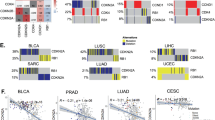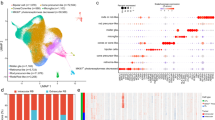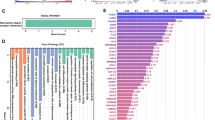Abstract
The paediatric eye tumour retinoblastoma is initiated by inactivation of RB1, a tumour suppressor on chromosome 13q. In addition to RB1 loss, many retinoblastomas show other genetic alterations including gains on chromosomes 6p21–pter and 1q31–q32. Recently, the minimal region of gains on chromosome 6 was narrowed to band p22. We examined genomic gains and expression changes in primary retinoblastomas to identify potential target genes in 6p22. Quantitative multiplex PCR detected copy numbers ⩾3 in 25 (33%) tumours and no gains in 31 of 76 (40%) tumours. The remaining 20 (26%) samples showed gains only at some loci, most often including E2F3 and DEK in 6p22.3. Analysis of RNA from 21 primary retinoblastomas showed that expression levels of these and some other genes in 6p22 correspond to DNA gains. However, KIF 13A, a reported candidate oncogene on 6p, was expressed at low levels or absent. Clinical manifestation of tumours with gains at all 6p22 loci was distinct in that distribution of age at diagnosis was markedly shifted to older age compared to tumours with no or partial gains. In summary, our results suggest that DEK and E2F3 are potential targets of 6p gains in retinoblastoma.
This is a preview of subscription content, access via your institution
Access options
Subscribe to this journal
Receive 50 print issues and online access
$259.00 per year
only $5.18 per issue
Buy this article
- Purchase on Springer Link
- Instant access to full article PDF
Prices may be subject to local taxes which are calculated during checkout



Similar content being viewed by others
References
Baugh LR, Hill AA, Brown EL and Hunter CP . (2001). Nucleic Acids Res., 29, E29.
Boonstra R, Koning A, Mastik M, van den Berg A and Poppema S . (2003). Virchows Arch., 443, 164–169.
Cano J, Oliveros O and Yunis E . (1994). Cancer Genet. Cytogenet., 76, 112–115.
Casas S, Nagy B, Elonen E, Aventin A, Larramendy ML, Sierra J, Ruutu T and Knuutila S . (2003). Leuk. Lymphoma, 44, 1935–1941.
Chen D, Gallie BL and Squire JA . (2001). Cancer Genet. Cytogenet., 129, 57–63.
Chen D, Pajovic S, Duckett A, Brown VD, Squire JA and Gallie BL . (2002). Cancer Res., 62, 967–971.
Classon M and Harlow E . (2002). Nat. Rev. Cancer, 2, 910–917.
Feber A, Clark J, Goodwin G, Dodson AR, Smith PH, Fletcher A, Edwards S, Flohr P, Falconer A, Roe T, Kovacs G, Dennis N, Fisher C, Wooster R, Huddart R, Foster CS and Cooper CS . (2004). Oncogene, 23, 1627–1630.
Fletcher O, Easton D, Anderson K, Gilham C, Jay M and Peto J . (2004). J. Natl. Cancer Inst., 96, 357–363.
Foster CS, Falconer A, Dodson AR, Norman AR, Dennis N, Fletcher A, Southgate C, Dowe A, Dearnaley D, Jhavar S, Eeles R, Feber A and Cooper CS . (2004). Oncogene, 23, 5871–5879.
Friend SH, Bernards R, Rogelj S, Weinberg RA, Rapaport JM, Albert DM and Dryja TP . (1986). Nature, 323, 643–646.
Gallie BL, Campbell C, Devlin H, Duckett A and Squire JA . (1999). Cancer Res., 59, 1731s–1735s.
Ginsberg D . (2004). Dev. Cell, 6, 742–743.
Herzog S, Lohmann DR, Buiting K, Schuler A, Horsthemke B, Rehder H and Rieder H . (2001). Hum. Genet., 108, 98–104.
Hoglund M, Gisselsson D, Hansen GB, White VA, Sall T, Mitelman F and Horsman D . (2004). Int. J. Cancer, 108, 57–65.
Horsthemke B . (1992). Cancer Genet. Cytogenet., 63, 1–7.
Hui R, Campbell DH, Lee CS, McCaul K, Horsfall DJ, Musgrove EA, Daly RJ, Seshadri R and Sutherland RL . (1997). Oncogene, 15, 1617–1623.
Kappes F, Damoc C, Knippers R, Przybylski M, Pinna LA and Gruss C . (2004a). Mol. Cell. Biol., 24, 6011–6020.
Kappes F, Scholten I, Richter N, Gruss C and Waldmann T . (2004b). Mol. Cell. Biol., 24, 6000–6010.
Koon N, Zaika A, Moskaluk CA, Frierson HF, Knuutila S, Powell SM and El-Rifai W . (2004). Neoplasia, 6, 143–149.
Lau CC, Harris CP, Lu XY, Perlaky L, Gogineni S, Chintagumpala M, Hicks J, Johnson ME, Davino NA, Huvos AG, Meyers PA, Healy JH, Gorlick R and Rao PH . (2004). Genes Chromosomes Cancer, 39, 11–21.
Mairal A, Pinglier E, Gilbert E, Peter M, Validire P, Desjardins L, Doz F, Aurias A and Couturier J . (2000). Genes Chromosomes Cancer, 28, 370–379.
Micci F, Walter CU, Teixeira MR, Panagopoulos I, Bjerkehagen B, Saeter G and Heim S . (2003). Cancer Genet. Cytogenet., 144, 119–124.
Mittnacht S . (2005). Eur. J. Cell Biol., 84, 97–107.
Nakagawa T, Tanaka Y, Matsuoka E, Kondo S, Okada Y, Noda Y, Kanai Y and Hirokawa N . (1997). Proc. Natl. Acad. Sci. USA, 94, 9654–9659.
Oeggerli M, Tomovska S, Schraml P, Calvano-Forte D, Schafroth S, Simon R, Gasser T, Mihatsch MJ and Sauter G . (2004). Oncogene, 23, 5616–5623.
Parisi T, Pollice A, Di Cristofano A, Calabro V and La Mantia G . (2002). Biochem. Biophys. Res. Commun., 291, 1138–1145.
Partheen K, Levan K, Osterberg L, Helou K and Horvath G . (2004). Genes Chromosomes Cancer, 40, 342–348.
Reifenberger G, Reifenberger J, Ichimura K, Meltzer PS and Collins VP . (1994). Cancer Res., 54, 4299–4303.
Saavedra HI, Wu L, de Bruin A, Timmers C, Rosol TJ, Weinstein M, Robinson ML and Leone G . (2002). Cell Growth Differ., 13, 215–225.
Sakowicz R, Finer JT, Beraud C, Crompton A, Lewis E, Fritsch A, Lee Y, Mak J, Moody R, Turincio R, Chabala JC, Gonzales P, Roth S, Weitman S and Wood KW . (2004). Cancer Res., 64, 3276–3280.
Sitwala KV, Mor-Vaknin N and Markovitz DM . (2003). Anticancer Res., 23, 2155–2158.
Squire J, Gallie BL and Phillips RA . (1985). Hum. Genet., 70, 291–301.
Squire J, Phillips RA, Boyce S, Godbout R, Rogers B and Gallie BL . (1984). Hum. Genet., 66, 46–53.
van der Wal JE, Hermsen MA, Gille HJ, Schouten-Van Meeteren NY, Moll AC, Imhof SM, Meijer GA, Baak JP and van der Valk P . (2003). J. Clin. Pathol., 56, 26–30.
Vogel F . (1979). Hum. Genet., 52, 1–54.
von Lindern M, Fornerod M, van Baal S, Jaegle M, de Wit T, Buijs A and Grosveld G . (1992). Mol. Cell. Biol., 12, 1687–1697.
Acknowledgements
We thank Claudia Gruss for providing DEK antibody and recombinant HIS-DEK. We thank Kathy Astrahantseff for critical reading of the manuscript. This work was supported by grants from the Deutsche Forschungsgemeinschaft (Klinische Forschergruppe Ophthalmologische Onkologie und Genetik KFO 109, Lo 530/6-1 and Ri 1123/1-1), Nationales Genomforschungsnetz (NGFN), the IFORES program of the Medizinische Fakultät der Universität Duisburg-Essen, and the Kulturstiftung Essen.
Author information
Authors and Affiliations
Corresponding author
Additional information
This work was presented in part at the AACR 95th annual meeting, March 2004
Rights and permissions
About this article
Cite this article
Grasemann, C., Gratias, S., Stephan, H. et al. Gains and overexpression identify DEK and E2F3 as targets of chromosome 6p gains in retinoblastoma. Oncogene 24, 6441–6449 (2005). https://doi.org/10.1038/sj.onc.1208792
Received:
Revised:
Accepted:
Published:
Issue Date:
DOI: https://doi.org/10.1038/sj.onc.1208792
Keywords
This article is cited by
-
A novel LncRNA transcript, RBAT1, accelerates tumorigenesis through interacting with HNRNPL and cis-activating E2F3
Molecular Cancer (2020)
-
Role of the DEK oncogene in the development of squamous cell carcinoma
International Journal of Clinical Oncology (2020)
-
The potential predictive value of DEK expression for neoadjuvant chemoradiotherapy response in locally advanced rectal cancer
BMC Cancer (2018)
-
γ-tubulin as a signal-transducing molecule and meshwork with therapeutic potential
Signal Transduction and Targeted Therapy (2018)
-
TFEB-VEGFA (6p21.1) co-amplified renal cell carcinoma: a distinct entity with potential implications for clinical management
Modern Pathology (2017)



